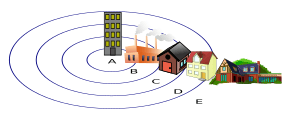Concentric zone model facts for kids
The Concentric Zone Model, also known as the Burgess Model, helps us understand how cities grow. It was created by Ernest W. Burgess between 1925 and 1929. Burgess studied the city of Chicago as it grew rapidly in the late 1800s and early 1900s. Many people were moving to Chicago back then.
This model was one of the first to explain why different groups of people lived in certain parts of a city. Burgess suggested that cities grow in a series of circles, or "zones," around the center. Each zone had a different main use.
Contents
What are the Five Zones of a City?
Burgess described five main zones, starting from the very center of the city:
- Zone 1: The Central Business District
- This is the heart of the city. It's where most businesses, shops, and offices are located. Think of it as the downtown area.
- Zone 2: The Transition Zone
- This area is right next to the city center. It has a mix of small businesses and older homes. Sometimes, these homes are divided into apartments. It's a busy place where things are always changing.
- Zone 3: The Working-Class Residential Zone
- This zone is home to many factory workers and people who need affordable housing. The homes here are usually older and less expensive. This area was sometimes called the "inner suburbs."
- Zone 4: The Residential Zone
- This zone has better quality homes and is often where middle-class families live. The houses are usually bigger and more expensive than those in Zone 3. This area was sometimes called the "outer suburbs."
- Zone 5: The Commuter Zone
- This is the outermost zone. People who live here often travel, or "commute," a longer distance to work in the city center. This zone includes smaller towns and villages that are connected to the main city.
How Does the Model Explain City Growth?
Burgess noticed that wealthier people often lived farther away from the city center. As a city grew, the central business district would expand. This would push the other zones outwards, like ripples in a pond. Each zone would try to expand into the next outer zone.
What are the Challenges of the Model?
While the Concentric Zone Model was important, it has some limitations:
- Assumes Flat Land: The model assumes a city can grow equally in all directions. But in real life, rivers, mountains, or large parks can stop a city from growing evenly.
- Doesn't Explain Commuter Towns: It doesn't fully explain why some towns far from the city might have cheap housing. These "commuter villages" don't always fit the pattern.
- Ignores Transportation: The model doesn't fully consider how different types of transportation (like trains or highways) can change how a city grows.
- Doesn't Fit All Cities: Not all cities grow in perfect circles. Some cities might grow along a river or a main road, creating different shapes.
Related City Models
See also
 In Spanish: Plano radioconcéntrico para niños
In Spanish: Plano radioconcéntrico para niños


